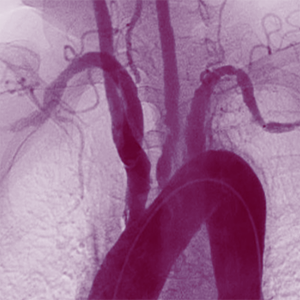Comparison of clinicodemographic characteristics and pattern of vascular involvement in 126 patients with Takayasu arteritis: a report from Iran and Turkey

Submitted: 4 March 2022
Accepted: 11 October 2022
Published: 29 December 2022
Accepted: 11 October 2022
Abstract Views: 886
PDF: 435
Publisher's note
All claims expressed in this article are solely those of the authors and do not necessarily represent those of their affiliated organizations, or those of the publisher, the editors and the reviewers. Any product that may be evaluated in this article or claim that may be made by its manufacturer is not guaranteed or endorsed by the publisher.
All claims expressed in this article are solely those of the authors and do not necessarily represent those of their affiliated organizations, or those of the publisher, the editors and the reviewers. Any product that may be evaluated in this article or claim that may be made by its manufacturer is not guaranteed or endorsed by the publisher.
Similar Articles
- Y. Emad, T. Gheita, H. Darweesh, P. Klooster, R. Gamal, H. Fathi, N. El-Shaarawy, M. Gamil, M. Hawass, R.M. El-Refai, H. Al-Hanafi, S. Abd-Ellatif, A. Ismail, J. Rasker, Antibodies to extractable nuclear antigens (ENAS) in systemic lupus erythematosus patients: correlations with clinical manifestations and disease activity , Reumatismo: Vol. 70 No. 2 (2018)
- F. Dall'Ara, I. Cavazzana, M. Frassi, M. Taraborelli, M. Fredi, F. Franceschini, L. Andreoli, M. Rossi, C. Cattaneo, A. Tincani, P. Airò, Macrophage activation syndrome in adult systemic lupus erythematosus: report of seven adult cases from a single Italian rheumatology center , Reumatismo: Vol. 70 No. 2 (2018)
- M. Fredi, M. Bianchi, L. Andreoli, G. Greco, I. Olivieri, S. Orcesi, E. Fazzi, C. Cereda, A. Tincani, Typing TREX1 gene in patients with systemic lupus erythematosus , Reumatismo: Vol. 67 No. 1 (2015)
- P. Montagna, R. Brizzolara, C. Ferrone, M. Cutolo, S. Paolino, M.A. Cimmino, A method for counting monosodium urate crystals in synovial fluid , Reumatismo: Vol. 67 No. 1 (2015)
- M. Taraborelli, M.G. Lazzaroni, N. Martinazzi, M. Fredi, I. Cavazzana, F. Franceschini, A. Tincani, The role of clinically significant antiphospholipid antibodies in systemic lupus erythematosus , Reumatismo: Vol. 68 No. 3 (2016)
- F. Salaffi, A. Ciapetti, P. Sarzi Puttini, F. Atzeni, C. Iannuccelli, M. Di Franco, M. Cazzola, L. Bazzichi, Preliminary identification of key clinical domains for outcome evaluation in fibromyalgia using the Delphi method: the Italian experience , Reumatismo: Vol. 64 No. 1 (2012)
- C. Bruni, S. Bellando-Randone, L. Gargani, E. Picano, A. Pingitore, M. Matucci-Cerinic, S. Guiducci, Critical finger ischemia and myocardial fibrosis development after sudden interruption of sildenafil treatment in a systemic sclerosis patient , Reumatismo: Vol. 68 No. 2 (2016)
- S. Soldano, P. Montagna, R. Brizzolara, C. Ferrone, A. Parodio, A. Sulli, B. Seriolo, B. Villaggio, M. Cutolo, Endothelin receptor antagonists: effects on extracellular matrix synthesis in primary cultures of skin fibroblasts from systemic sclerosis patients , Reumatismo: Vol. 64 No. 5 (2012)
- E. Bernero, A. Sulli, G. Ferrari, F. Ravera, C. Pizzorni, B. Ruaro, G. Zampogna, E. Alessandri, M. Cutolo, Prospective capillaroscopy-based study on transition from primary to secondary Raynaud’s phenomenon: preliminary results , Reumatismo: Vol. 65 No. 4 (2013)
- A. Alunno, O. Bistoni, F. Pratesi, F. Topini, I. Puxeddu, V. Valentini, G. Cafaro, E. Bartoloni, P. Migliorini, R. Gerli, Association between anti-citrullinated alpha enolase antibodies and clinical features in a cohort of patients with rheumatoid arthritis: a pilot study , Reumatismo: Vol. 70 No. 2 (2018)
You may also start an advanced similarity search for this article.

 https://doi.org/10.4081/reumatismo.2022.1487
https://doi.org/10.4081/reumatismo.2022.1487





